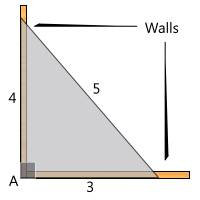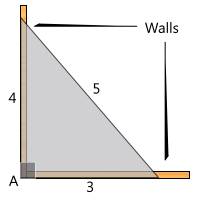Looking to learn about the math involved in carpentry? Wondering how numbers and measurements play a role in this craft? Well, look no further! In this article, we’ll explore what math is used in carpentry and how it helps carpenters build amazing structures. So, grab your toolbox and let’s dive in!
Whether you’re constructing a sturdy wooden shelf or framing a house, carpentry relies heavily on math. From basic addition and subtraction to more complex geometry and trigonometry, carpenters use a range of mathematical concepts to ensure precise measurements and accurate cuts. By understanding and applying these math principles, carpenters can create structures that are not only beautiful but also safe and functional.
So, if you’re passionate about woodworking or thinking of pursuing a career as a carpenter, understanding the math behind the craft is essential. In this article, we’ll break down the specific math skills that come into play, explore how to measure and calculate angles, discuss fractions and decimals, and much more. Get ready to unleash your inner math-savvy carpenter and take your woodworking skills to new heights!

What Math is Used in Carpentry?
Carpentry is a skilled trade that involves working with wood to create structures, furniture, and other wooden objects. While many may assume that carpentry is solely about working with wood, math actually plays a crucial role in this craft. From measuring materials to calculating angles and dimensions, carpenters rely on various mathematical concepts and calculations to ensure precise and accurate work. In this article, we will explore the specific math skills and applications that are used in carpentry, highlighting their importance in achieving professional and high-quality results.
1. Measurement and Conversion
Every carpenter knows that accurate measurements are the foundation of their work. From the length and width of materials to the distance between joints and the dimensions of a finished structure, precise measurements are essential for ensuring proper fit and alignment. Carpenters use various tools, such as tape measures, rulers, and calipers, to measure lengths, widths, and depths. Understanding and applying different units of measurement, such as inches, feet, and meters, is also vital for converting measurements and ensuring consistency throughout a project. This mathematical skill helps carpenters determine the amount of materials needed and ensures that everything fits together seamlessly.
2. Geometry and Angles
Geometry plays a significant role in carpentry, particularly when it comes to working with angles, shapes, and dimensions. Carpenters use geometric principles to calculate and cut angles for joints, roofs, and staircases, ensuring that everything fits together perfectly. Understanding different types of angles, such as acute, obtuse, and right angles, is essential for achieving structural stability and aesthetic appeal. Additionally, knowledge of basic geometric shapes, such as squares, rectangles, and triangles, helps carpenters identify and create patterns for repetitive tasks or complex designs.
3. Algebra and Arithmetic
Algebra and arithmetic are fundamental mathematical concepts that carpenters use on a daily basis. Carpenters often need to solve equations to determine the measurements and quantities of materials required for a project. This involves calculating areas, volumes, and surface areas of structures, as well as determining the amount of paint, wallpaper, or flooring needed to cover a specific space. Arithmetic skills, such as addition, subtraction, multiplication, and division, are also important for calculating costs, estimating project durations, and ensuring accurate measurements.
4. Trigonometry
Trigonometry is another branch of mathematics that finds practical applications in carpentry. Carpenters use trigonometric functions, such as sine, cosine, and tangent, to calculate distances, heights, and angles that are not directly measurable. Trigonometry is particularly useful when working with inclined surfaces, roofs, or other structures that require precise measurements and calculations. By applying trigonometric principles, carpenters can determine the necessary lengths of rafters, the angles of cuts for sloping surfaces, and the dimensions of complex shapes.
5. Estimation and Budgeting
While not strictly mathematical concepts, estimation and budgeting are skills that carpenters must possess to ensure the success of their projects. Carpenters often need to estimate the quantities of materials needed, the project duration, and the overall cost. This involves considering variables such as waste, overlaps, and potential errors. By utilizing estimation techniques and budgeting skills, carpenters can plan and execute projects efficiently, minimizing waste and maximizing resources.
6. Ratio and Proportion
Ratio and proportion are mathematical concepts that carpenters use to ensure proper scaling and symmetry in their work. These concepts are particularly important when enlarging or reducing plans or designs. Carpenters need to maintain the proportional relationships between different elements to create visually appealing structures. By understanding ratios and proportions, carpenters can adjust measurements and dimensions while maintaining the overall aesthetic and functionality of the finished product.
7. Technology and Computer-Aided Design (CAD)
With advancements in technology, carpenters are increasingly using computer-aided design (CAD) software to plan and visualize their projects. CAD software allows carpenters to create detailed, accurate, and 3D representations of their designs. While the software handles most of the mathematical calculations, carpenters still need a good understanding of math to interpret and make adjustments to the digital plans. This integration of technology and math enables carpenters to streamline their workflow and create precise and intricate structures.
As you can see, math is an integral part of carpentry, providing the foundation for accuracy, precision, and efficiency in the trade. From measuring and converting units to calculating angles and dimensions, carpenters rely on a range of mathematical concepts to create beautiful and functional wooden structures. Whether it’s through measurement and conversion, geometry and angles, algebra and arithmetic, trigonometry, estimation and budgeting, ratio and proportion, or technology and CAD, math is essential for carpentry success. So, the next time you admire a well-crafted piece of woodwork, remember the math behind it all.
Key Takeaways:
- Carpentry involves using math in various aspects of the job.
- Measurement is a crucial skill in carpentry, requiring knowledge of fractions, decimals, and geometry.
- Calculating angles plays a significant role in carpentry for proper cuts and joinery.
- Understanding ratios and proportions helps in scaling plans and ensuring accurate dimensions.
- Basic algebra is used to calculate quantities and solve mathematical problems encountered in carpentry.
Frequently Asked Questions
When it comes to carpentry, mathematics plays an important role in various aspects of the craft. From measuring and calculating dimensions to estimating material quantities, math skills are crucial for carpenters to ensure accurate and precise work. Here are some commonly asked questions about the math used in carpentry:
1. How do carpenters use math for measurements?
Carpenters use math to measure distances, angles, and dimensions accurately. They apply concepts like addition, subtraction, multiplication, and division to calculate lengths, widths, and heights. Understanding fractions and decimals is essential for converting measurements and solving mathematical problems encountered during carpentry projects.
For example, when constructing a wall, carpenters need to measure and mark locations for studs, windows, and doors with precision. They also need to calculate the spacing between each component to ensure the structure is sturdy and visually appealing. Math skills enable carpenters to work efficiently and avoid mistakes.
2. What math is used when cutting materials?
Carpenters use math when cutting materials to ensure they make accurate and precise cuts. Geometry plays a significant role in determining the angles and shapes needed for various cuts. Carpenters also rely on math to calculate measurements for miter joints, where two pieces of material are joined at an angle.
Understanding concepts like Pythagorean theorem, trigonometry, and angles helps carpenters make bevel cuts, compound cuts, and complex angled cuts. By applying mathematical calculations, carpenters can create well-fitted joints and achieve desired outcomes in their projects.
3. How does math help carpenters estimate material quantities?
Mathematics is essential for carpenters to estimate the quantity of materials required for a project. By calculating the surface area or volume of the space to be worked on, carpenters can determine how much lumber, plywood, or other materials they need to purchase. They consider the dimensions and thickness of the materials to make accurate estimations.
Additionally, carpenters use math to calculate waste factors, accounting for offcuts and errors that may occur during the construction process. Understanding mathematical formulas and ratios enables carpenters to plan their material purchases efficiently, minimizing costs and reducing waste.
4. How is math applied in building codes and regulations?
Mathematics is crucial in understanding and interpreting building codes and regulations for carpentry projects. Carpenters use math to ensure compliance with safety standards, load-bearing requirements, and structural stability. They apply mathematical calculations to determine the maximum span for joists, the size of beams, and the capacity of fasteners.
Carpenters also use math to calculate allowable deflection, which refers to the amount of bending or flexing a structural element can have without compromising its strength or safety. By precisely following mathematical guidelines outlined in building codes, carpenters can ensure that their structures meet all necessary requirements.
5. How is math used in cost estimation for carpentry?
Mathematics plays a crucial role in cost estimation for carpentry projects. Carpenters use math to calculate labor costs, material prices, and overhead expenses. They consider variables such as the complexity of the project, the time required for completion, and the cost of materials to create accurate estimates for clients or project budgets.
By applying mathematical formulas, carpenters can determine the total cost of a project, including factors like transportation, tools, insurance, and any additional expenses. Math helps carpenters make informed decisions when pricing their services and ensures that project budgets are realistic and financially viable.

Carpenter Math : Two Ways to Square a Building – Pt 1
Summary
Want to be a carpenter? Math is important! You’ll use measuring, geometry, and fractions every day. Math helps you build and create awesome things. So keep learning and have fun with numbers!
Carpentry is a practical skill that relies on math. Measuring accurately, understanding shapes, and working with fractions are all part of being a great carpenter. So don’t be afraid of math – embrace it and use it to build amazing things!
